|
|
| |
|
|
| |
|
|
|
|
| |
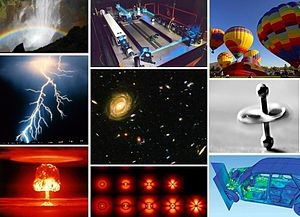 |
| Various examples of
physical phenomena. |
Physics
Physics (from Ancient Greek: φυσική (ἐπιστήμη),
romanized: physikḗ (epistḗmē), lit. 'knowledge of
nature', from φύσις phýsis 'nature') is the natural
science that studies matter, its motion and behavior
through space and time, and the related entities of
energy and force. Physics is one of the most fundamental
scientific disciplines, and its main goal is to
understand how the universe behaves.
Physics is one of the oldest academic disciplines and,
through its inclusion of astronomy, perhaps the oldest.
Over much of the past two millennia, physics, chemistry,
biology, and certain branches of mathematics were a part
of natural philosophy, but during the Scientific
Revolution in the 17th century these natural sciences
emerged as unique research endeavors in their own right.
Physics intersects with many interdisciplinary areas of
research, such as biophysics and quantum chemistry, and
the boundaries of physics are not rigidly defined. New
ideas in physics often explain the fundamental
mechanisms studied by other sciences and suggest new
avenues of research in academic disciplines such as
mathematics and philosophy.
Advances in physics often enable advances in new
technologies. For example, advances in the understanding
of electromagnetism, solid-state physics, and nuclear
physics led directly to the development of new products
that have dramatically transformed modern-day society,
such as television, computers, domestic appliances, and
nuclear weapons; advances in thermodynamics led to the
development of industrialization; and advances in
mechanics inspired the development of calculus. |
|
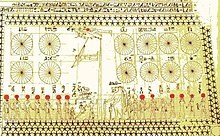 |
| Ancient Egyptian
astronomy is evident in monuments like the
ceiling of Senemut's tomb from the Eighteenth
Dynasty of Egypt. |
History
Ancient astronomy
Astronomy is the oldest natural science. The Sumerians,
Ancient Egyptians, and Indus Valley Civilization all
understood how the things in the sky moved since before
3000 BC.
A lot of astronomy comes from Mesopotamia, Babylonia,
Ancient Egypt, and Ancient Greece. Most names for
constellations came from Greek astronomers.
Natural philosophy
Natural philosophy started in Greece around 650 BC when
some philosophers rejected superstition and decided
things had to happen for a reason. Leucippus and his
student Democritus suggested the idea of the atom around
this period.
Physics in the medieval
Islamic world
Islamic scholars continued to study Aristotelian physics
during the Islamic Golden Age. They also developed an
early form of the scientific method.
Scientists like Ibn Sahl, Al-Kindi, Ibn al-Haytham, Al-Farisi
and Avicenna worked a lot on optics and vision. In The
Book of Optics, Ibn Al-Haitham rejects previous Greek
ideas and comes up with a new theory about vision.
Classical physics
Physics became a separate field of study after the
scientific revolution.
Galileo's experiments helped to create classical
physics. And although he did not invent the telescope,
he noticed that the stars and planets were not perfect.
He also investigated gravity.
Isaac Newton used Galileo's ideas to put together his
three laws of motion. |
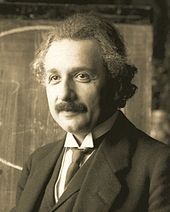 |
| Albert Einstein
(1879–1955), whose work on the photoelectric
effect and the theory of relativity led to a
revolution in 20th century physics. |
Modern physics
As research progressed, scientists found things that
classical mechanics did not explain.
Classical mechanics predicted that the speed of light
varied, but experiments showed the speed of light stayed
the same. This was predicted by Albert Einstein's theory
of special relativity. Einstein predicted that the speed
of electromagnetic radiation through empty space would
always be the same. His view of space-time replaced the
ancient idea that space and time were quite separate
things.
Max Planck came up with quantum mechanics to explain why
metal releases electrons when you shine a light at it,
and why matter emits radiation. Quantum mechanics
applies for very small things like the electrons,
protons, and neutrons that make up an atom. People like
Werner Heisenberg, Erwin Schrödinger, and Paul Dirac
continued to work on quantum mechanics and eventually we
got the Standard Model. |
|
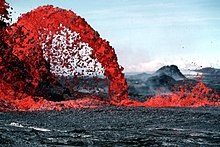 |
| This parabola-shaped
lava flow illustrates the application of
mathematics in physics—in this case, Galileo's
law of falling bodies. |
Definition
Physics is the study of energy and matter in space and
time and how they are related to each other. Physicists
assume the existence of mass, length, time and electric
current and then define (give the meaning of) all other
physical quantities in terms of these basic units. Mass,
length, time, and electric current are never defined but
the standard units used to measure them are always
defined. In the International System of Units
(abbreviated SI from the French Système International),
the kilogram is the basic unit of mass, the metre is the
basic unit of length, the second is the basic unit of
time, and the ampere is the basic unit of electric
current.
In addition to these four units, there are three other
ones: the mole, which is the unit of the quantity of
matter, the candela which measures the luminous
intensity (the power of lighting) and the kelvin, the
unit of temperature.
Physics studies how things move, and the forces that
make them move. For example, velocity and acceleration
are used by physics to show how things move. Also,
physicists study the forces of gravity, electricity,
magnetism and the forces that hold things together.
Physics studies very large things, and very small
things. For instance, physicists can study stars,
planets and galaxies but could also study small pieces
of matter, such as atoms and electrons.They may also
study sound, light and other waves. As well as that,
they could examine energy, heat and radioactivity, and
even space and time. Physics not only helps people
understand how objects move, but how they change form,
how they make noise, how hot or cold they will be, and
what they are made of at the smallest level.
Physics and mathematics
Physics is a quantitative science because it is based on
measuring with numbers. Mathematics is used in physics
to make models that try to guess what will happen in
nature. The guesses are compared to the way the real
world works. Physicists are always working to make their
models of the world better. |
|
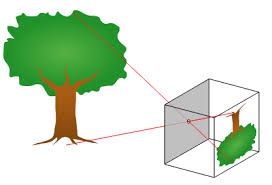 |
| The basic way a
pinhole camera works. |
Advanced knowledge
General description
Physics is the science of matter and how matter
interacts. Matter is any physical material in the
universe. Everything is made of matter. Physics is used
to describe the physical universe around us, and to
predict how it will behave. Physics is the science
concerned with the discovery and characterization of the
universal laws which govern matter, movement and forces,
and space and time, and other features of the natural
world.
Breadth and goals of physics
The sweep of physics is broad, from the smallest
components of matter and the forces that hold it
together, to galaxies and even larger things. There are
only four forces that appear to operate over this whole
range. However, even these four forces (gravity,
electromagnetism, the weak force associated with
radioactivity, and the strong force which holds protons
and neutrons in an atom together) are believed to be
different parts of a single force.
Physics is mainly focused on the goal of making ever
simpler, more general, and more accurate rules that
define the character and behavior of matter and space
itself. One of the major goals of physics is making
theories that apply to everything in the universe. In
other words, physics can be viewed as the study of those
universal laws which define, at the most basic level
possible, the behavior of the physical universe.
Physics uses the scientific
method
Physics uses the scientific method. That is, data from
experiments and observations are collected. Theories
which attempt to explain these data are produced.
Physics uses these theories to not only describe
physical phenomena, but to model physical systems and
predict how these physical systems will behave.
Physicists then compare these predictions to
observations or experimental evidence to show whether
the theory is right or wrong.
The theories that are well supported by data and are
especially simple and general are sometimes called
scientific laws. Of course, all theories, including
those known as laws, can be replaced by more accurate
and more general laws, when a disagreement with data is
found.
Physics is quantitative
Physics is more quantitative than most other sciences.
That is, many of the observations in physics may be
represented in the form of numerical measurements. Most
of the theories in physics use mathematics to express
their principles. Most of the predictions from these
theories are numerical. This is because of the areas
which physics has addressed work better with
quantitative approaches than other areas. Sciences also
tend to become more quantitative with time as they
become more highly developed, and physics is one of the
oldest sciences. |
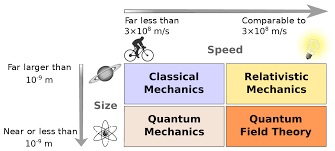 |
| The basic domains of
physics. |
Fields of physics
Classical physics normally includes the fields of
mechanics, optics, electricity, magnetism, acoustics and
thermodynamics. Modern physics is a term normally used
to cover fields which rely on quantum theory, including
quantum mechanics, atomic physics, nuclear physics,
particle physics and condensed matter physics, as well
as the more modern fields of general and special
relativity. Although this difference can be found in
older writings, it is of little new interest as quantum
effects are now understood to be of importance even in
fields that before were called classical.
Approaches in physics
There are many approaches to studying physics, and many
different kinds of activities in physics. There are two
main types of activities in physics; the collection of
data and the development of theories.
The data in some subfields of physics is amenable to
experiment. For example, condensed matter physics and
nuclear physics benefit from the ability to perform
experiments. Experimental physics focuses mainly on an
empirical approach. Sometimes experiments are done to
explore nature, and in other cases experiments are
performed to produce data to compare with the
predictions of theories.
Some other fields in physics like astrophysics and
geophysics are mostly observational sciences because
most of their data has to be collected passively instead
of through experimentation. However, observational
programs in these fields use many of the same tools and
technology that are used in the experimental subfields
of physics.
Theoretical physics often uses quantitative approaches
to develop the theories that attempt to explain the
data. In this way, theoretical physics often use tools
from mathematics. Theoretical physics often can involve
creating quantitative predictions of physical theories,
and comparing these predictions quantitatively with
data. Theoretical physics sometimes creates models of
physical systems before data is available to test and
support these models. There are many important uses of
physics like measuring houses or any measure. Also, it
can be used to measure falling objects like planes.
These two main activities in physics, data collection
and theory production and testing, use many different
skills. This has led to a lot of specialization in
physics, and the introduction, development and use of
tools from other fields. For example, theoretical
physicists use mathematics and numerical analysis and
statistics and probability and computer software in
their work. Experimental physicists develop instruments
and techniques for collecting data, using engineering
and computer technology and many other fields of
technology. Often the tools from these other areas are
not quite appropriate for the needs of physics, and need
to be changed or more advanced versions have to be made. |
|
|
 Kiddle: Physics Kiddle: Physics
Wikipedia: Physics |
|
|
|
|
|
|
|
|
|
|
|
|
|
|
|
|
|
|
Search Fun Easy English |
|
|
|
|
|
|
|
|
|
|
|
|
|
|
|
About
Contact
Copyright
Resources
Site Map |